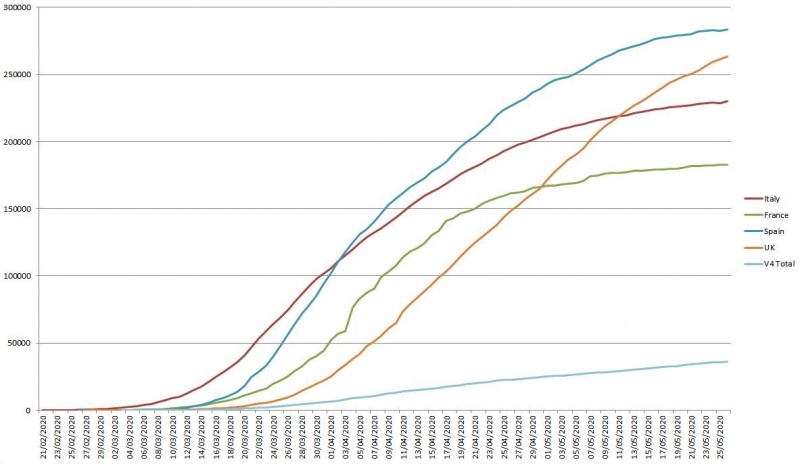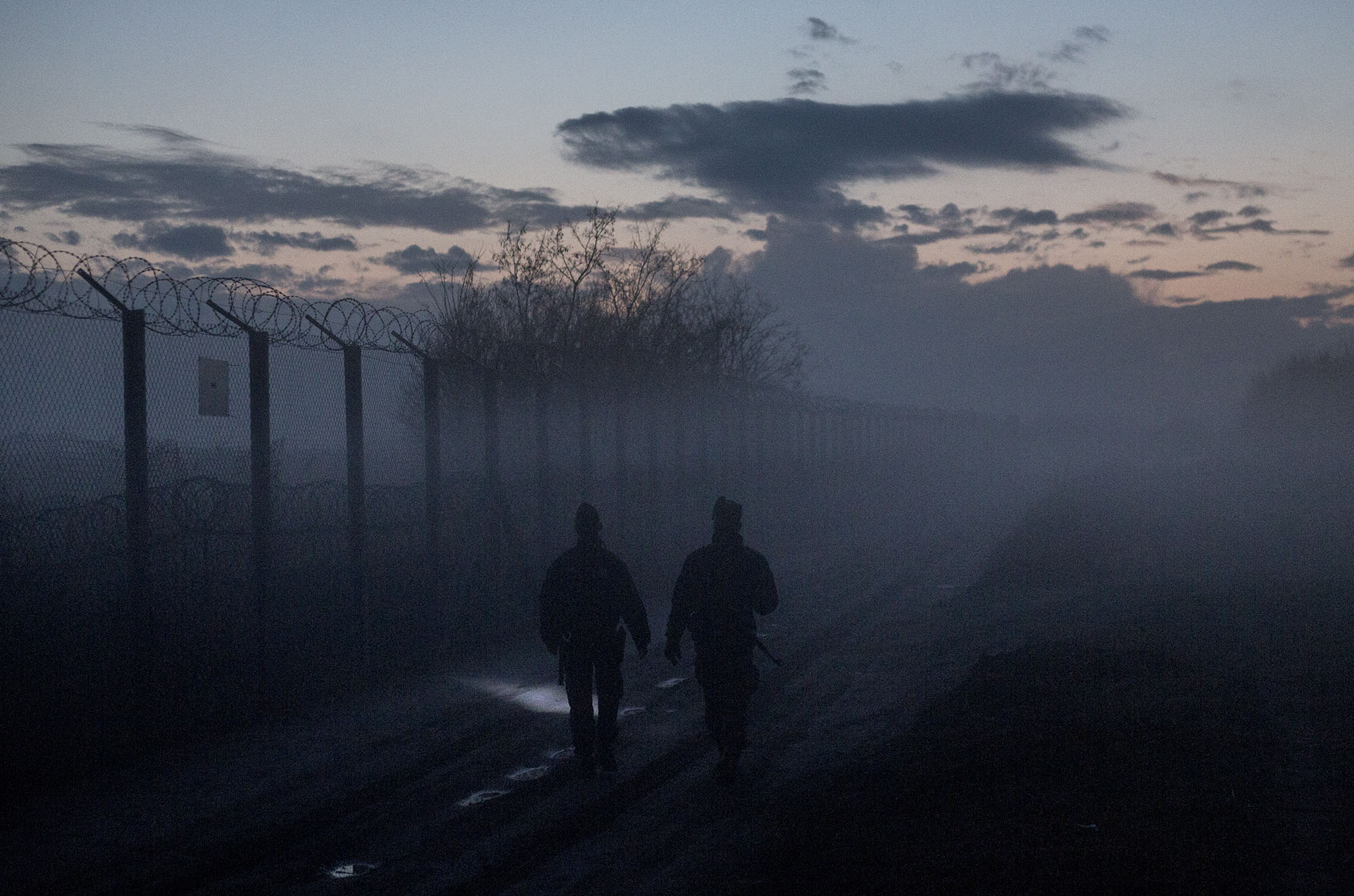Having reacted faster to the COVID-19 pandemic than their Western European counterparts, the four countries of the Visegrád Group (Poland, the Czech Republic, Slovakia and Hungary) were also among the first to reduce their lockdown measures – which were less stringent than in most Western European countries anyway – and to reactivate their economies. As a consequence, although it is forecast that the impact of the pandemic and of forced social distancing on their economies will be very costly, on average predictions are somewhat less catastrophic for the Visegrád Four than for the Western part of the continent, although in that matter the European Commission’s spring 2020 forecast differs significantly from the IMF’s predictions published in April (see here for details). According to the European Commission, Poland will experience the smallest recession in the whole EU, with an economic slump amounting to “only” 4.3% of GDP. But according to the IMF, this year’s recession will be least significant in Hungary, with a fall of 3.1%. For Hungary, the EC predicts a 7% slump this year. According to figures from the EC, the scale of the decline in GDP will be below the EU and euro area averages (respectively 7.4% and 7.7%) for all four countries of the V4, as it will amount to 6.2% for the Czech Republic and 6.7% for Slovakia. However, the current situation is so dynamic and unprecedented in its nature that predictions are of little value at the current stage, as most European countries have not yet even returned to their normal economic activity, some lockdown measures still being in place. But in the countries of the V4, non-essential businesses were never closed so widely as in the UK, France, Italy, and Spain. In the first quarter of 2020, Poland and Hungary could still boast year-on-year growth rates of respectively 1.6% and 2.7%, although the Czechia and Slovakia were already in recession, with falls of 2.2% and 4.1%. At the same time, the year-on-year fall in GDP amounted to 2.3% in Germany, 1.6% in the UK, 5.4% in France, 4.1% in Spain and 4.8% in Italy.
The impact of the temporary closure of automotive factories
Among the Visegrád Four, Slovakia was particularly hard hit because of the temporary closure of factories belonging to foreign car makers, which make up a significant part of Slovakia’s GDP. In total, the automotive industry accounts for 13% of Slovakia’s GDP and 35% of its exports, and within the V4 Slovakia was thus certain to be the most affected by the closure of factories by foreign car makers in March and April and by the steep fall in demand for new cars all over Europe. The automotive industry is also an important branch of the Czech economy, albeit less so than in Slovakia, as it accounts for 9% of GDP and a quarter of exports, which is about the same level as in Hungary. It is of less importance in Poland, with a share of about 8% in GDP and 13% in exports. Most car makers restarted production in the four countries in the Visegrád Group in the second half of April, and some had already done so in the first half of that month.
Lifting the lockdown in Poland
In Poland, the third and penultimate set of measures lifting the lockdown came into force on May 18. Although special sanitary measures have to be observed, restaurants and bars can now serve customers both outdoors and indoors. Previously, since the beginning of the lockdown in mid-March, they had only been allowed to offer takeaway and delivery services. On May 18 hairdressers and beauty parlours could reopen after one and a half months of forced closure. Two weeks after nursery schools, primary schools have partially reopened to younger children (first- to third-graders), although attendance is still not compulsory. From June 1 schools will have to provide consultations for older pupils preparing for exams (those in the final year of primary school and secondary school). Starting on May 25, universities are allowed to renew on-site classes for final-year students. More commuters are now allowed on public transport, and a higher number of worshippers can attend religious services. Sports venues were also reopened on May 18, with limits put on the numbers of persons training together indoors and outdoors, and some sports clubs have thus been able to restart their activities. There have been no limits on travelling within Poland, but borders remain closed to non-resident foreigners (except for lorry and coach drivers) with compulsory quarantine for returning nationals and residents remaining in place at least until June 12. Starting May 4, the quarantine obligation was lifted for cross-border workers at the border with Germany. On May 17, that measure was extended to all cross-border workers coming from EU and EEA countries. International flights will remain suspended at least until June 14, and the national carrier LOT is to renew its national flights starting June 1. Since May 4, hotels and commercial centres have been able to reopen their doors, while stores outside shopping malls were allowed to remain open throughout the lockdown period. At the same time as commercial centres, museums and libraries were also allowed to reopen. Wearing face masks in public spaces became compulsory on April 16, when people were again allowed to go to parks and woods, and this acted as a signal for Poles that they could now go out more freely, so that increasing numbers of people have been seen on the streets and in stores since that date. Several coal mines had to suspend working in May because of an outbreak of COVID-19 among miners; the coal-mining region of Upper Silesia became Poland’s epicentre of the epidemic, while the spread of the coronavirus seemed to be largely under control in other regions of the country. A state of emergency has never been declared in Poland during the current epidemic, all restrictions being imposed based on a much narrower “state of epidemic”. On May 27 Prime Minister Mateusz Morawiecki announced that from June 6 there would be no limit on the number of people in stores and churches, and that wearing a face mask will no longer be compulsory when being outside. Starting June 6 cinemas, theatres, opera houses, swimming pools, fitness clubs and leisure parks will also be allowed to reopen.
Lifting the lockdown in Hungary
In Hungary, the next phase of the lifting of the lockdown came into force on May 18, the same day as in Poland. Like in Poland, stores and other businesses never had to fully close their doors, although shops could remain open until 3 p.m. only, a limitation which did not apply to food stores and pharmacies. On May 4, beaches as well as the terraces and gardens of restaurants and cafés were reopened, and restrictions on opening hours for stores were lifted – with the 9 a.m. to 12 p.m. time slot still being reserved for people over 65 – together with most lockdown measures in the whole of the country except for the capital Budapest. Budapest restaurants and cafés were allowed to reopen their outdoor seating areas on May 18, and other lockdown measures were lifted that day in the Hungarian capital, two weeks after the rest of the country. Outside Budapest, restaurants and bars can also have customers indoors. Just as in Poland, in Hungary restaurants and bars were at all times permitted to provide takeaway sales and delivery services. With the lifting of the lockdown, covering one’s mouth and nose became compulsory on public transport and in all shops on May 4. In Budapest, since April 27 it had already been obligatory to wear a mask on public transport, in taxis, in stores and in open-air markets. Starting May 18 all services can be provided if distancing and sanitary measures can be ensured. Open-air swimming pools were allowed to reopen, as well as open-air museums and zoos. Child-care centres, nursery schools and schools are to reopen from June 2, although remote teaching will remain the norm until the end of the school year. The maximum number of people attending religious services and ceremonies will be increased to 200 starting June 1 (June 15 in Budapest). No date has yet been given for the reopening of cinemas, theatres and museums. Starting May 22 Romanian citizens transiting from Romania through Hungary are exempt from the quarantine rule, but the general rule remains that borders are closed to non-resident foreigners, while all returning nationals and residents have to undergo a 14-day period of self-isolation. These strict rules do not apply to lorry drivers and cross-border workers. New exemptions also came into force in early May, including for business travel between affiliated companies having premises in Hungary and Austria. Austria, Hungary, Czechia and Slovakia are planning to fully open their mutual borders from mid-June. On May 28 Hungary fully reopened its border with Slovenia, which was the first European country to declare an end to its coronavirus epidemic in mid-May. In early May the Hungarian airline WizzAir was the first in Europe to resume some of its international flights, after suspending them on March 24. During his weekly interview on Kossuth Rádió on May 22, Prime Minister Viktor Orbán confirmed that the state of alarm giving the government extra powers would be ended the following week as it was no longer necessary.
Lifting the lockdown in Czechia
In Czechia, most remaining restrictions were to be lifted on May 25, while the heaviest limitations on free movement and retail trade had already been lifted in late April after a ruling by Prague’s district court that they were illegal. From May 25 people no longer have to wear face masks in outdoor public spaces (on March 19, Czechia and Slovakia were the first two countries in Europe which made wearing face masks outside people’s homes compulsory, following the example set by Asian countries in the fight against the coronavirus). Hotels, restaurants and bars are now fully open, as well as indoor spaces in zoos and botanical gardens, castles, swimming pools, solariums and saunas. Mass events are also allowed from that date if attended by up to 300 people. All theatres and cinemas, as well as museums and galleries, were allowed to reopen on May 11. Having ordered the closure of various types of stores and services in March, the Czech government gradually allowed them to reopen throughout the month of April. Among other things, restaurants and bars were allowed to reopen for takeaway sales on April 9. Practising sport in outdoor venues has been allowed since April 20. On that date, universities could also partially reopen for the purpose of enabling students to prepare for their exams. Starting from May 25, pupils can also return to primary schools on a voluntary basis. Since April 23, Czech citizens have again been able to leave the country and to return and avoid quarantine by presenting a fresh negative result of a COVID-19 test. From March 16 to April 22 the Czech borders had been closed both ways (to foreigners wishing to enter and to Czech nationals wishing to leave the country). From May 26 Czechia planned to reopen most of its border crossings and conduct random border controls instead of systematic ones. Starting May 18, Czech Airlines resumed their flights to and from Prague after having kept their planes grounded for over two months (since March 13). As happened on the Polish side, in the Moravian-Silesian Region coal mining was affected in May by new outbreaks of COVID-19 among miners.
Lifting the lockdown in Slovakia
In Slovakia too, since May 20 people have no longer had to wear face masks outdoors when they can keep a safe distance from people who do not live in the same household. On that date indoor tourist attractions were allowed to open, except for zoos and botanical gardens, and the maximum number of people allowed in stores was increased from one person per 25 square metres to one per 15 square metres. Starting May 20 commercial centres can reopen, as can cinemas and theatres, and mass events can again be organised, but for a maximum number of 100 people. Indoor swimming pools and venues are now open, but for sports teams only. As for outdoor sports venues, they are now open for contact sports too. Restaurants and bars can serve customers inside with the same limits as for outdoor service (including a 2-metre distance between table corners). All shops are still required to close on Sundays, and there are still dedicated hours for people over 65. Nursery schools and primary schools (first- to fifth-graders) are set to reopen on June 1 (with up to 15 children per group in nursery schools and up to 20 in primary schools), but attendance will not be compulsory. Starting May 21 people with permanent or temporary residence in Slovakia travelling to the Czech Republic, Poland, Hungary, Austria, Croatia, Slovenia, Switzerland and Germany no longer have to undergo quarantine if they return within 24 hours.
Progression of the COVID-19 pandemic before, during, and after the lockdown in the V4

Economic consequences of the lockdown in the V4
The gradual lifting of restrictions which started in the first half of April is good news for the economies of the Visegrád Four, but it is too soon to assess how fast production, consumption and exports will bounce back. The figures given above for the first quarter do not reflect the extent of the damage done to national economies by the pan-European lockdown, with much harsher measures taken in several big Western European countries, where most non-essential activities were stopped for almost two months. In Slovakia, for example, in spite of the measures taken by the government to mitigate the effect of the crisis, the month-to-month rise in the unemployment rate in April (the first full month of lockdown) was the highest in the country’s history, with unemployment reaching 6.57%, up 1.38 percentage points from March. In Poland, figures published on May 21 by the National Statistical Office (GUS) show that industrial production fell by 24.6% in April compared to a year earlier, and by 25.5% compared to March. Until then, the largest fall in production in the last 20 years had been recorded in January 2009, during the financial crisis, and had amounted to 15.3% year-on-year. Like in Slovakia, the automotive sector is hardest hit, with a 78.9%(!) year-on-year fall in production in April. In the Czech Republic industrial production already fell by 8.7% in March, and the figure will certainly be much worse in April. In Hungary, while most restrictions came into force in the second half of March, GDP fell by 0.4% in the first quarter compared to the last quarter of 2019. Figures for April will be published at the end of May, and will inevitably be much worse.
The Visegrád Four in a better situation than countries like Italy, France, Spain, and the UK
Nevertheless, the countries of the Visegrád Four are in a better situation than the UK, France, Italy and Spain, where lockdown measures even now remain more stringent. It was only on May 11 that France started loosening the restrictions that kept people in their homes except when going out for essential reasons, which had to be documented on a written attestation, with maximum time limits for being outside. The regime was even more stringent in Spain, where the first phase of lifting of the lockdown that came into force on May 2 only allowed people to go outside for a walk on their own or with people from the same household. In Italy, when the first step for lifting the lockdown came into force on May 4, people could only move within their own region for work, in case of necessity or for their health. Even in the second half of May the general rule was still that people were not allowed to travel freely between different regions of their country in the UK (with strict “stay home” rules still remaining in force in Wales, Scotland and Northern Ireland), France, Spain and Italy. Broadly speaking, while the Visegrád Four were evolving between the third and fourth phases of exit from lockdown – with social distancing measures remaining in place – the aforementioned four countries of Western Europe were still between phase zero and phase two, depending on region. From the second half of March to the beginning of May, people in those countries were only allowed to leave their homes for short times and for basic necessities, with all shops selling non-essential goods having to close.
As a result, overall GDP slumped by 32% in the last two weeks of March in France. In the same period of time the UK average weekly worked hours fell from 31.6 to 24.8 and the number of people temporarily away from jobs jumped from 2.16 million to 7.41 million. In Italy, the number of hours paid by the public insurance scheme for short-time working (forced reduction of worked hours) jumped 3,761% from March to April, to a total of 772 million hours. In Spain, industrial prices fell by 8.4% in April compared to April 2019, which was the highest rate of deflation since 1975. While the full picture for April was not yet available in the second half of May, these are just a few hard numbers illustrating the kind of nosedive the economies of those countries have taken because of the lockdown.
The Visegrád Four as net contributors to a future Recovery Fund?
At the same time, at the end of last year public debt stood at 46% of GDP in Poland, 66.3% of GDP in Hungary, 30.8% of GDP in the Czech Republic, and 48% of GDP in Slovakia. That gives those four countries more room for manoeuvre in the current crisis than in the case of Italy, which already had a debt-to-GDP ratio of 134.8% in 2019, compared to 98.1% for France, 95.5% for Spain, and 85.4% for the UK. On the other hand, thirty years after the fall of communism the countries of the Visegrád Group remain poorer than France, Italy, and Spain, and the proposal made by Germany’s Angela Merkel and France’s Emmanuel Macron to create a Recovery Fund worth €500 billion, which would issue European debt financed by the EU-27 and give non-refundable grants to countries which have suffered most from the pandemic – above all to Italy, Spain, and France – is meeting strong resistance in Central Europe. Thus, Czech Prime Minister Andrej Babiš has now joined leaders of countries like Austria, the Netherlands and Finland in their criticism of such a €500 billion grant proposal, arguing that “It would be unfair to be penalised for being successful in dealing with the epidemic.” Hungary could also very well be one of the financial losers of the new Recovery Fund, which is additionally intended by French and German leaders to favour more financial and fiscal integration between member states. Critical voices could be heard in Poland too after the Franco-German proposal was announced on May 18, and a week after that announcement the Polish daily newspaper Rzeczpospolita published a chart showing that, based on the European Commission’s latest economic forecasts, both Poland and Czechia would be net contributors to the new Recovery Fund, along with the northern countries of the EU (Germany included).
Progression of the COVID-19 pandemic before, during, and after the lockdown in Italy, France, Spain, the UK, and the V4

Note:
The population of the Visegrád Group taken together is roughly equivalent to that of Italy (60.3 million), France (67 million) or the UK (67.5 million). With 38.4 million people in Poland, 10.6 million in Czechia, 9.8 million in Hungary and 5.5 million in Slovakia, the total for the V4 is 64.3 million. Spain has a population of 46.7 million inhabitants.
This article was originally published on Kurier.plus.




